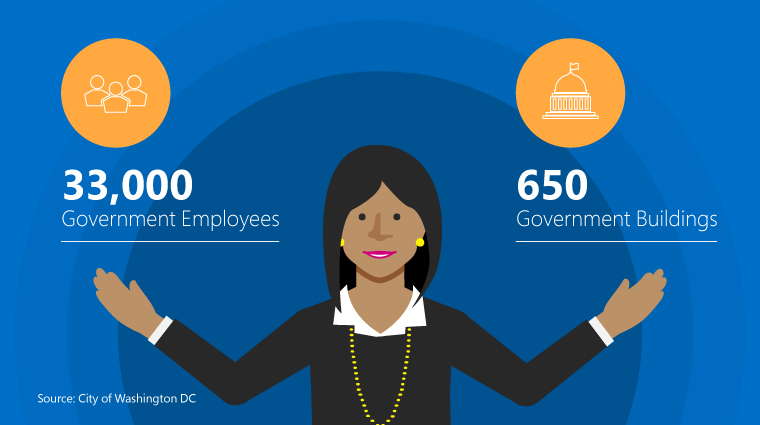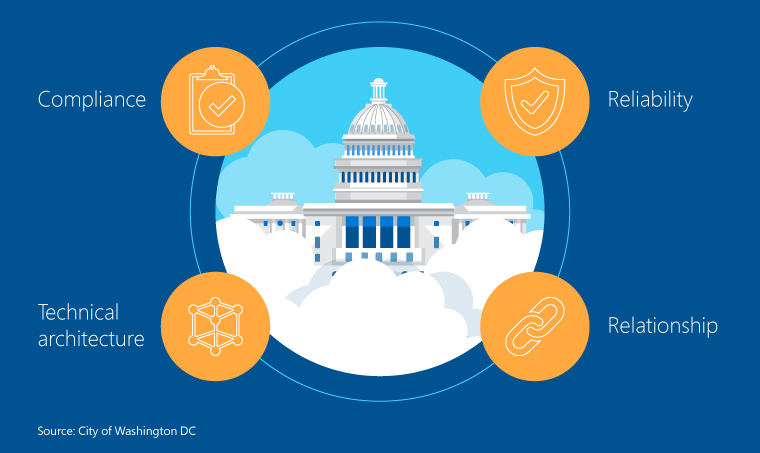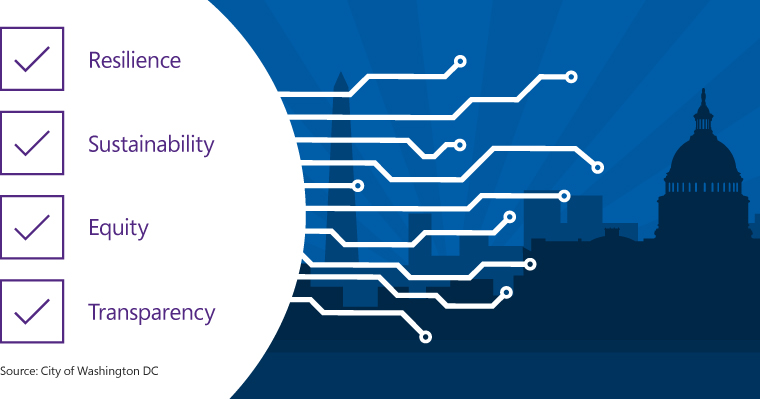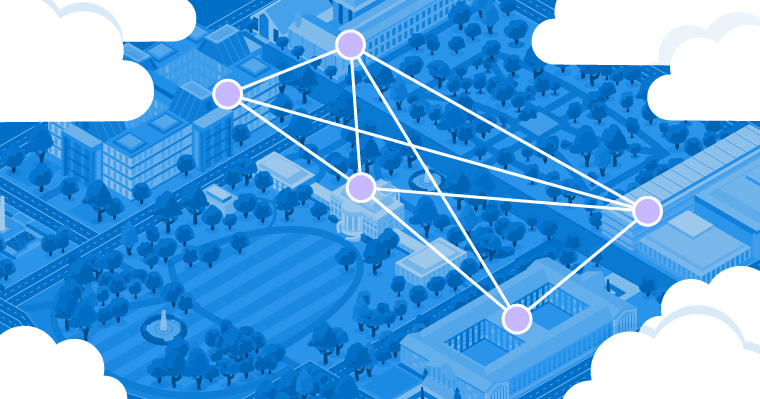
How Washington, DC is creating an innovative future in the cloud
| Focus on: Engaging citizens, empowering employees, optimizing operations, transforming services |
Washington, DC’s dual functions—both as the nation’s capital and its own metropolitan area—operate simultaneously, presenting a host of unique needs, challenges and priorities. The Office of the Chief Technology Officer (OCTO), where I serve as Chief Technology Officer, provides technology services to 33,000 government employees, network connectivity to more than 650 government buildings, and all the enterprise services that DC requires to successfully provide city services to DC residents. My team cannot be successful without inventive work, collaborative efforts, and efficient technologies, motivating us to constantly explore new ways to imagine safe, inclusive, thriving American cities.
 DC’s unique infrastructure informs my office’s short- and long-term decision-making and outlines the city’s technological needs. DC’s transient population is another defining characteristic of the city. While there are only approximately 680,000 residents living within DC’s city limits as of the 2016 census, daily commuters and other visitors increase the city’s population to over a million people every day. The city’s hundreds of thousands of visitors might not be full-time residents, but my staff and I are still required to provide the same city services for DC’s transient population as we do for our local citizens. For us, Microsoft offers a strong government cloud platform and services that help me and my staff perform our jobs effectively and create the city’s digital future.
DC’s unique infrastructure informs my office’s short- and long-term decision-making and outlines the city’s technological needs. DC’s transient population is another defining characteristic of the city. While there are only approximately 680,000 residents living within DC’s city limits as of the 2016 census, daily commuters and other visitors increase the city’s population to over a million people every day. The city’s hundreds of thousands of visitors might not be full-time residents, but my staff and I are still required to provide the same city services for DC’s transient population as we do for our local citizens. For us, Microsoft offers a strong government cloud platform and services that help me and my staff perform our jobs effectively and create the city’s digital future.
Identifying digital needs and service standards to support the nation’s capital
In most cities across the country, public servants care about the same eight basic city-related issues: public safety, housing, equity and economic development, aging infrastructure, education, environment and energy, healthcare, and budget. Public servants and city governments manage and address these concerns depending on the priorities of a given city. In DC, our most significant technological needs, most pressing technological challenges, and most effective technological strategies all relate to two major considerations: efficiency and economic value. In order for my office to operate effectively while addressing the city’s needs, time and cost considerations are a consistent focus.
Identifying your city’s strategic priorities means highlighting the city-wide trends and characteristics that make your city distinct. In DC, the fluid population density and need for reliable transportation options is a key challenge. My office requires technology that can adapt to rapidly shifting populations and substantial scale changes that are in flux every day. With 1,500 miles of road stretching across the city and 9% of our water pipes dating back to the Civil War, my office is interested in technological services that can successfully support our transportation, city services, and infrastructure, regardless of the population needs in any given season.
Before beginning the search for specific technologies and digital platforms to meet DC’s digital needs, we identified our own list of standards for government cloud service providers. The first three criteria are compliance, reliability and the technical architecture and environment of the platform. The fourth standard—which is the most important, and the most difficult to meet—is the quality and efficiency of the relationship between the Office of the Chief Technology Officer and the cloud provider. Regardless of the other three standards, without the right collaborative partnership, our technology needs won’t be met, and our office won’t be able to successfully serve the city.
Transforming city services to build a “SmarterDC”
As DC’s Chief Technology Officer, I certainly believe in investing in the District’s digital future as a way to improve residents’ quality of life, energize our local economy, and address the city’s complex challenges. The “SmarterDC” initiative is a wide-reaching collaborative effort designed to explore potential digital solutions. Without a deliberate plan set in place, digital transformations can sometimes result in a technology-focused endeavor that deviates from its initial user-driven purpose. So rather than emphasizing the technology for this initiative, my office’s primary focus is on clearly identifying our vision, and then finding the most efficient, cost effective technologies we can implement to drive that vision forward.
Developing a collective model for a “SmarterDC” was a joint effort between my office and multiple city-stakeholders. We established a four-part list of criteria to guide our plan to digitally transform the District. First and foremost, we determined that a city cannot be “Smart” without also being resilient. We wanted to enhance the city’s ability to bounce back—and bounce back quickly—from any natural or man-made crisis. Second, in our most ideal vision of DC, sustainability is a key focus. The goal would be for every project across the District to be developed with a sustainable lens and to commit to sustainable practices. Third, the District views equity as a top priority across all eight wards. DC is a richly diverse metropolitan area, and all of our digital solutions should strive to take the entire spectrum of the city into consideration. Our fourth criteria for a “SmarterDC” is transparency and collaboration. Increased transparency and communication within the government leads to stronger points of synergy and more opportunities for collaboration. More effective collaborative efforts can dramatically increase efficiency and cut costs across the board. A city-wide digital transformation guided by these four principles ensures that our ultimate vision for a safe, inclusive, thriving city can and will be realized.
Combining Microsoft’s digital solutions with OCTO’s implementation strategies
From the beginning, my staff and I could tell that Microsoft’s team would facilitate the service-oriented partnership that we were looking for, making our decision to use Microsoft’s government cloud technology an easy one. Microsoft’s adherence to compliance, obvious reliability, and user-friendly technical architecture all supported our needs. Everyone we interacted with at Microsoft had the exact collaborative attitude we needed in a service provider. They were always willing to escalate service or bring in additional personnel to clarify whenever necessary. As a service provider, instead of being focused on selling a product, Microsoft made it clear to me and my staff that they were focused on helping the city succeed.
We’re also in the process of transitioning all 33,000 government employees across DC to Microsoft Office 365 Government by the end of the fiscal year. With Microsoft’s cloud technology, leveraging all the tools that come with Microsoft Office 365 supports efficiency across the entire city government, and optimizes collaboration opportunities that could potentially span multiple agencies and projects. The application Groups has also been an invaluable organizational tool. Every program office has its own Group, with designated places for coordination and collaboration. As the Chief Technology Officer, I’m able to toggle freely between Groups, allowing me to engage with various projects easily, and offering additional visibility and an overall understanding of the agency’s current projects.
As we planned for our city-wide digital transformation, the Office of the Chief Technology Officer also had to develop a strategic plan for implementing the technology efficiently and successfully. We began with an agency-wide rollout, switching our staff of 650 people to Microsoft Office 365 Government. Because of the smaller scale, we were able to easily identify the possible issues before beginning the city-wide transition, allowing us to plan for potential challenges. The limited rollout gave my office the opportunity to invest more resources in change management, allowing us to develop new forms of communication and engagement to offer better tech support.
Using technology to transform our cities
As technology develops and digital capabilities expand, compliance and resiliency will remain two major qualifications for a successful cloud service. In addition to those factors, having a collaborative and communicative relationship between an agency and their service provider is absolutely critical. For DC’s Office of the Chief Technology Officer, Microsoft offered all of these services and more, facilitating a city-wide digital transformation that will bring DC toward a more resilient, sustainable, equitable, and transparent digital future.








